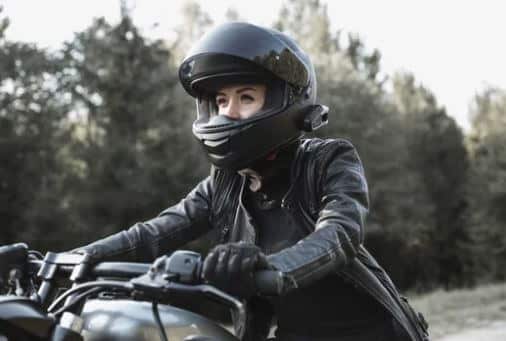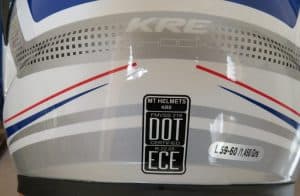Full Face helmets are the most essential component of a motorcyclist’s safety gear. In event of an accident, it is the critical piece of safety equipment that can protect your head from impact and abrasion. It is the only thing between your head and the ground.
You should always invest in a good, full-face helmet (aka full coverage) for your greatest safety. A full-face helmet for motorcyclist (full coverage) covers your entire head, face, and your chin with a single structure.
Full-Face helmets are big as they have several layers of shell material, a thick expanded polystyrene liner (EPS), and plush comfort padding in them. All these components, the shell, EPS liner, and padding are needed to cushion and protect your head during an impact. As a result, they look so big. These cushions include foam, fabric pads amongst several other things.
It is important to select the right helmet size to keep yourself safe. Any compromise with this step can lead to tragedy later. It does not matter what the helmet is made from or how high the quality is if it comes off during a crash.
I bring to you a what-you-need-to-know about your helmet size and how to select the most appropriate size for your safe biking. Read on to find all about it.
| Helmet Model | Category | Price (RRP) | Check & Shop Now |
|---|---|---|---|
| AGV K1 S | Best Sport/Road | $229.95 | RevZilla | MotoSport | Amazon |
| KYPARA | Best Cruiser/ATV | $99.90 | Amazon |
| Yema | Best Street/Urban | $69.99 | Amazon |
| Torc Modular | Best Cruiser/Touring | $149.99 | Amazon |
| ILM Z501 | Best Dual Sport/Street | $139.99 | Amazon |
| Bell Qualifier | Best Urban/Commuter | $129.95 | RevZilla | MotoSport | Amazon |
| Scorpion EXO-R420 | Best Sport/Touring | $164.95 | RevZilla | CycleGear | Amazon |
| Icon Airform | Most Versatile | $159.00 | RevZilla | MotoSport | CycleGear |
| Sedici Strada 3 | Best Bluetooth-Enabled | $279.99 | RevZilla | CycleGear | J&P Cycles |
Why Are Full Face Helmets So Big?

Full coverage or full-face helmets are the safest of all the helmet types. At times people get daunted by the look of its large size and obscure looks. But we can tell you that the big size is for a reason. The reasons are as follows:
- The manufacturers put in several layers of protective material inside a helmet to keep your head safe. These linings increase the volume of the helmet and thereby its size. The more the distance between your head and the outer shell of the helmet, the better.
- Many a time, the user has a big head. This leads to even bigger helmets that look out of the picture.
- Another reason that your helmet seems to be big is that you could have chosen the wrong helmet size. If you do not know how to choose the correct helmet for yourself, you may end up with a bigger size. This not only looks bad but also unsafe.
Finding Yourself the Right Helmet Size
Your helmet may look bigger than usual as you may have selected the wrong helmet. It is especially important to select the correct helmet size to avoid any safety issues. There are a few steps to find out if you have selected the right helmet or not:

Steps to find out if your helmet is oversized:
- Ensure that most of the interior lining meets your face. At the same time, it should not cause any discomfort or hot spots on your cheeks, neck, or head.
- Wear the helmet and try to insert two fingers in it. If the fingers go in smoothly, the helmet is loose – it is bigger.
- When you wear the helmet, try rotating it. If it is a good fit, it will not turn sideways or move up/down.
What to Do If Your Full-Face Helmet Is Too Large, Too Big?
Once you have figured out that your helmet is oversized for you, there are a couple of things you might be able to do to fix the situation. These are:
- Contact the helmet manufacturer as you may be able to replace the inner lining of your helmet with thicker lining material. This will fill the firm up the helmets fit between your head and the helmet’s EPS liner. This technique is useful when your helmet is just loose and needs a small change.
- Use thicker pads: If your helmet is quite loose, replace the inner pads with thicker ones. You will find helmet pads at any standard motorcycle accessory shop.
- Replace the helmet: It is best to change your helmet to the right fit if you find your existing helmet to be a loose fit. A factory-made, the proper fit helmet is the best bet for any mishap that you may have to face. Read on to find how to select the best fit helmet for yourself.
1. Selecting The Right-Sized Full-Face Helmet for Yourself
It is important to know how to select the right-sized helmet for safe motorcycling. There are a few steps involved in selecting the correct helmet. They are as follows:
- Measuring your head: Since helmets come in many different shapes and sizes, it is important to measure your head first. Take a seamstress measuring tape and measure the complete round of your head. Do so by keeping the measuring tape half an inch above your eyebrow.
- Identifying your head shape: The human head can be of different shapes. Accordingly, helmets are of different shapes. You need to first identify the shape of your head. It is usually of three types:
- Long oval head: When the head is longer from front to back as compared to side to side.
- Round oval head: When the head is equally long from front to back and side to side.
- Intermediate oval head: When the head is slightly longer from front to back as compared from side to side.
- Trying the helmet: Once you know your head size and shape, it is time for you to try the helmet. Different helmet brands may fit very differently so try out a few models before finalizing the best for yourself. You can verify by trying to put your fingers in between the helmet and your head. Or try by rotating your head from left to right and top to bottom.
If you are confused between two consecutive sizes, we recommend you take the smaller one. Due to the soft padding inside, you can snug your head into the helmet. And at the same time, have a proper fit.
2. Helmet Certification Standards
Motorcycle helmets in the US are made per standards set for the safety of motorcyclists. The most common standards are the DOT, ECE, and SNELL standards. The DOT standards are set by the U.S. Department of Transportation. All helmets in the US have to mandatorily pass the DOT standards.

The SNELL standards are fixed by the SNELL Memorial Foundation. SNELL has been testing helmets since the 1950s. They upgrade their test parameters every five years. The SNELL standards are significantly higher than the DOT requirements.
3. Caring For Your Helmet
The helmet is an important and expensive gear. You must take good care of it. It by all means is the only thing between you and a fatal accident. Here are a few suggested steps to take care of your helmet.
- Visual inspection: Always check your helmet before using it. Any crack in the outer shell, loose or broken chin-strap lock should not be ignored. A broken visor or spoilt inner lining should be immediately addressed.
- Expiry date: Though it sounds strange, helmets also have an expiry date. Check your helmet tags (or its documents) for the same. Usually, it is recommended to replace the helmet every five years. At the same time, your helmet hygiene also plays a crucial role in its lifespan.
- Washing the helmet lining: if your helmet has removable cheek pads and liners, wash them occasionally. This will keep them clean and increase their life. Use a mild detergent and cold water to do so.
- Check the EPS: Your helmet has a foam lining called Expanded Polystyrene. It takes most of the impact during a crash. Since EPS breaks down with hair oil and time, check the foam lining occasionally. If it has turned flaky or deteriorated, buy a new helmet.
Michael’s Summary and Conclusion
Full-face helmets look big as it has many layers of components- shell, liner, and comfort padding in it. They are important as these layers take the impact during an accident.
It is also possible that you have selected the wrong size for yourself. As mentioned, you can check if the helmet is a loose fit. You can then work around the problem or select a new, correct-fit helmet for yourself.

I've diligently categorized my motorcycle gear recommendations into all available categories, with the aim of providing you with a comprehensive analysis that showcases the absolute best options for all your needs. These items are the culmination of in-depth research, extensive testing, and personal use throughout my vast experience of 50+ years in the world of motorcycling. Besides being a passionate rider, I've held leadership positions and offered consultancy services to reputable companies in over 25 countries. To See Top Picks and the Best Prices & Places to Buy: Click Here! |
Information for this article was partially sourced and researched from the following authoritative government, educational, corporate, and non-profit organizations:
ND













